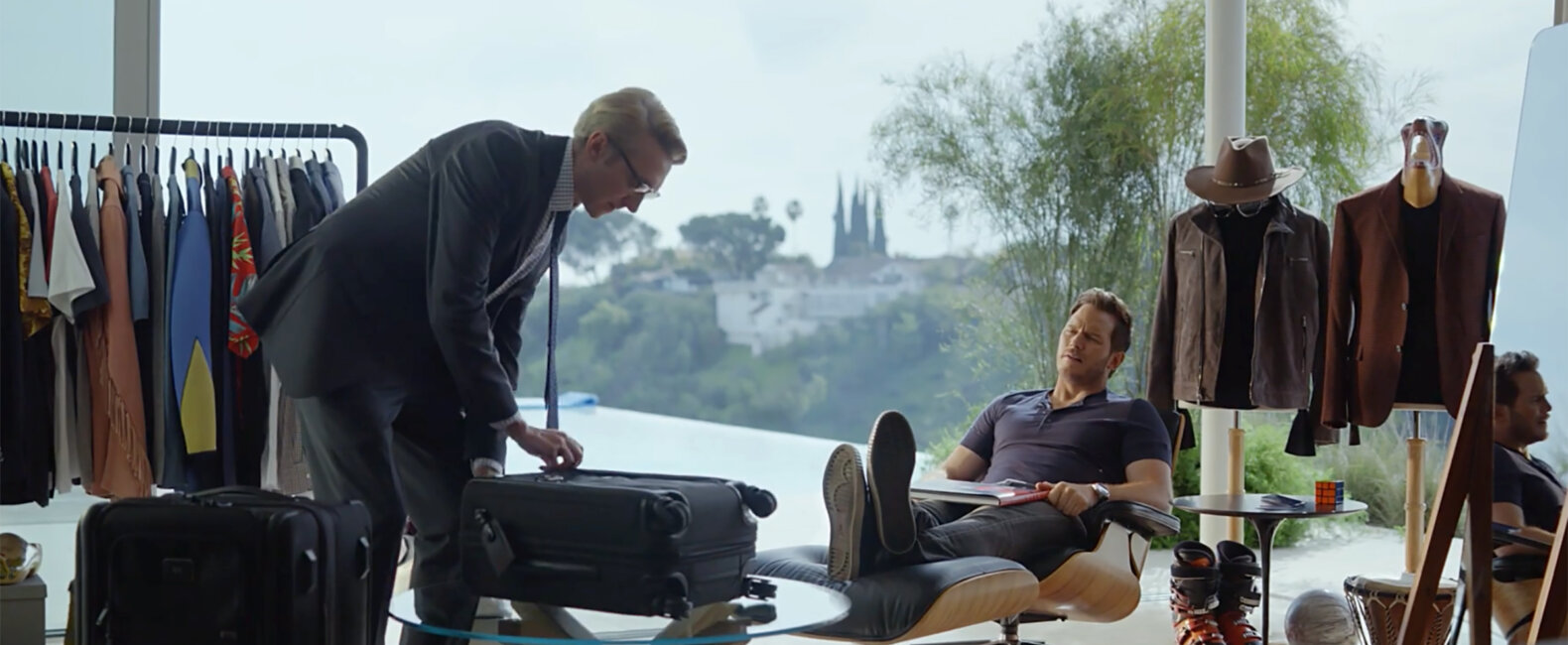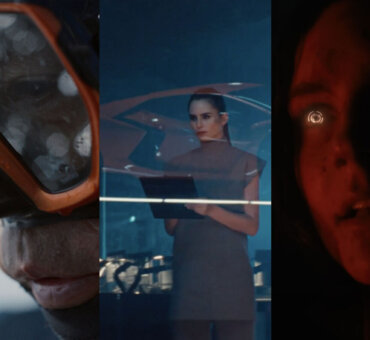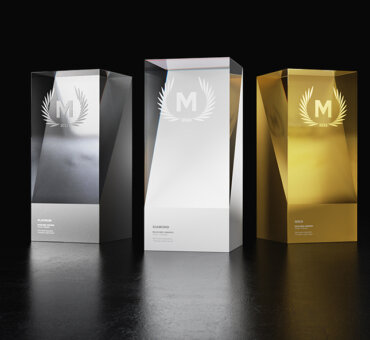We’re celebrating the unsung heroes of filmmaking by speaking with veteran producers about their craft, perspective, and process. To learn how Musicbed can make your own process easier—with preferred rates, same-day quotes, and free song pitches—click the link below to create a free account.
Film productions are deceptive in the best way. They make something incredibly complicated seem incredibly simple. And producers are the people holding up that veil—the wizards who somehow work miracles from pre-production through to post. Take Stink Studio’s Executive Producer Omid Fatemi, for example. He’s behind the TUMI x Chris Pratt spot, which is simple on the surface, yet infinitely effective—a funny film about a man packing for his first trip to Hong Kong.
Of course, it helps to have Chris Pratt as your talent—but, there’s so much more to this project than that. And that’s where Omid’s magic tricks come in.
He had to deliver a concept with talent already locked in. Integrate the spot with a larger campaign. Shift a brand’s tone and voice. Represent the product well. And then shoot it all in 12 hours. No one knows any of this when they see the finished product, which is a producer’s entire job.
We had the privilege to break down the TUMI x Chris Pratt project with Omid and dive into the nuances of how a high-level producer navigates a production. He had great insights about being an advocate for both the brand and the creative team throughout the process. Here’s Omid.
Musicbed: How did Stink get involved with the TUMI x Chris Pratt project?
Omid Fatemi: They’re a client of ours and we were working with their global office quite extensively for the global campaign. One of the teams in the Asia-Pacific region reached out and wanted us to do something specifically for their region.
Where did you start in the process?
It always starts with the brand and understanding their needs, their audience, their desired output—and, of course, what their budget is. I take that information, process it, and then brief our creative team here—our creative director, art directors, copywriters, designers, filmmakers. I share with them what the client has asked for, what they will be asking for, and try to anticipate what the project will evolve into.
How do you communicate all of that to your team?
I always start with understanding the creative team that I have. Leaning into their skill sets as designers, filmmakers, writers, etc. I want to set the stage for them to get excited about the project creatively. I like to explain the opportunities, explain how the campaign will go out, where it will go, and going through the talent’s previous work—Chris Pratt in this case.
Outside of that pep rally portion, I try to give our team clear guide rails to make their work as efficient as possible. I don’t like to be overly instructive with creative, but I also don’t want them to waste their time. I try to give them the key points—whether it’s budget or it’s timeline or location—to them a target for their creativity.
The brand knew they had Chris Pratt. They knew the product line they wanted to push. They also had very specific circumstances we had to work in—mainly Chris’ location and schedule.
It forced us to shoot in Los Angeles, where Chris is located, but at the same time we wanted to create the idea of travel. That’s where our two-part idea came in—to capture his travel before he heads to Hong Kong and the process of packing. It’s different than the kind of film TUMI normally likes to do.
How did they differ and how did that conversation go with the client?
The biggest difference is that the brand tends to be a bit more serious and sophisticated and doesn’t necessarily use comedy to push their campaigns. But, we had the opportunity of working with Chris and we thought it’d be a miss if we didn’t take advantage of it. So, there’s a lot more comedy and personality woven into this campaign, more so than we would normally do.
To TUMI’s credit, they knew they wanted to capture Chris’ personality. They knew his personality leans towards humor, but they didn’t necessarily know how to go about it. That’s where we started working with our creative team and brought in one of our directors from Stink Films, Traktor, who has a really great history of comedy.
How much did you concept change during the process?
The idea evolved a lot during the developmental phase. The prior films had taken a documentary approach and we initially wanted to try and capture Chris’ personality that way. As we dove into it more, though, we thought doing something scripted would be better. That’s just Chris’ world and that process was going to allow us to get the best out of him.
We wanted to create something that Chris felt accustomed to and we thought it was best to create some familiarity. It evolved into less of a look into the life of a person and more like a short film that captures his personality and comedy.
We communicate clearly so our client feels like they’re part of the process, so they feel considered and not just a reflection of our creativity.
What’s your strategy for conveying those changes to a client?
The first thing I do—regardless of how collaborative it really is—is I try to make it feel collaborative. I try to frame our ideas as inspired by them or inspired by the brief. I try to point out anything we can latch onto as inspiration, anything that shows how we want to position the brand in a certain way.
We communicate clearly so our client feels like they’re part of the process, so they feel considered and not just a reflection of our creativity. We still want to show our creativity, but not just stuff that is off the wall. It’s about finding a proper balance.
It seems like they seemed open to new ideas.
They were definitely open to doing things differently. We talked about how we all wanted to depict Hong Kong and represent the Chinese culture in a way that felt authentic, respectful, and considerate. As Americans, as Westerners, even though we were working with our China team as well—we have an office in Shanghai—we really wanted to listen to our client clearly about the cultural nuances in the way that we were speaking to that market. Not just generic, global language.

How did you work within all of these constraints—budget, timeline, location?
The budget was tight. But, it’s not so much about the budget; it’s more about what the brand expects from the budget. They want video, photo, social. They want the whole shebang. Our production team did a great job being as efficient as possible and managing time as much as possible, creating a plan in advance for photo and video.
We’re all shooting on the same set, sharing the same time, and it involves a lot of coordination between the two units. We had to think about everything in a considered way. When you have the point where budgets are tight, you really want to avoid spending money frivolously on anything that won’t end up on camera.
The location itself was not just for aesthetics, but for the room and the feasibility of operating two productions at once. When we’re looking at locations, we have to consider our ability to move around the space and capture enough unique looks between the two units. There was definitely a good combination of indoor and outdoor space—which our photographer and director both needed. Logistically too, there was a great space for us to stage the production—our crews, equipment, catering, etc—to be able to move around the space without blocking a shot. The final, and most important part, is that the price was right.
How did the actual shoot go?
Because of the limited amount of time someone like Chris Pratt has, it was a really tight production. It was a one-day shoot, twelve hours, which is a lot. It wasn’t difficult in the sense that there were a bunch of props we didn’t anticipate; I would just say managing things from an energy standpoint.
As a producer, what can you do to manage your team’s energy on a shoot like that?
Food. Snacks. Morale. I try to communicate as much as possible and react to things that are happening positively. If there’s an amazing shot or an amazing scene that the client or I are responding to positively, I like to share that with the team. Especially once we start to get towards the end of the day and things start to drag.
I think it’s a combination of being able to be as efficient as possible with the notes that I’m giving, so it doesn’t feel like they’re spinning their wheels. Being enthusiastic so they feel appreciated. And also trying to stay out of the way and balance those three things. As an executive producer, the last thing I want to do is have the loudest voice on the set.
I’m trying to give the client vision of that gap—that what they’re seeing on the monitor may or may not look the way it does in the final film.
What sort of notes were you giving on-set?
In this case, the client would point out something as simple as, “We need the zippers on the other side.” Or the proper way to display it. Or even responding to a moment where we were able to show a bit more personality to connect with an audience. It’s a mixture between hardcore creative and more product-oriented requests.
Also, with the clients not being filmmakers, they’ll always have questions about the production or why something looks a particular way. It’s really about explaining the process. I can point out things really quickly, like “That’ll get fixed in color” or “That’ll get masked out in post.” I’m trying to give the client vision of that gap—that what they’re seeing on the monitor may or may not look the way it does in the final film.
For example, there was a moment where we were doing the packing sequence. We were actually filming the sequence backwards and then we’d run it in reverse to give it a surrealness while also being able to land on the perfect fold. Knowing that Chris is not a professional at folding clothes, we decided to start with the perfect fold and then have him unfold it and then run it in reverse so we could land on the perfect fold.
With techniques like those, you have to kind of explain to the client to let them know this is how we’re going to land on the perfect fold and also give us a bit of creative quality.
How do you think the final product turned out?
The brand seemed really enthusiastic. I actually went out to Hong Kong to see the installation rolled out. There was incredible enthusiasm. People were really excited about Chris being there. Sometimes it’s hard to gauge if people are excited about your creative or if they’re excited about Christ Pratt [laughs]. For us, it’s about putting something together that’s creative and fun—and then getting out of the way.




















































































